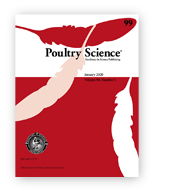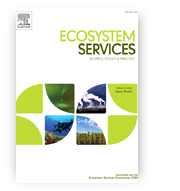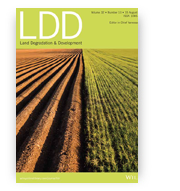Characteristics of semen collected from gander included in the genetic resources conservation program
Ewa Łukaszewicz, Artur Kowalczyk, Anna Jerysz
Poultry Science
 Conservative breeding ex situ in vivo is one of the most popular methods of creating genetic reserves. Unfortunately, keeping animals in small closed populations leads to inbreeding which reduces their reproductive capacity. The aim of the study was to characterize the sperm quality of six genetic groups of geese (northern and southern breeds) kept in Poland for many generations as genetic reserve flocks. Each breed was represented by 10 randomly selected one-year-old ganders, semen was collected 14 times, individually from each male, and the number of positive reactions (ended with ejaculation), semen volume, sperm concentration and morphology were assessed. The obtained results showed a significant difference between breeds and individuals of the same group, both in males’ reaction and semen quantitative and qualitative traits. From the northern breeds 193 ejaculates were obtained in total (i.e., 45.9% of all attempts), from the southern breeds 242 ejaculates (57.6%). The volume of single ejaculate varied from 0.01 mL (one drop allowing only histological smear and sperm morphology evaluation) to 0.65 mL; sperm concentration varied from 23.0 × 106mL−1 to 2376.0 × 106mL−1; the amount of total live sperm was at a similar level in all breeds (89.6% - 97.7%), while live normal cells ranged between 15.2% - 67.9% depending on breed and individuals. When keeping the genetic reserves ex situ in vivo, attention should be paid to the quality of semen and males that are poor in this respect should be eliminated, in order not to lead to an excessive weakening of the reproductive capacity of the flocks covered by the genetic resources protection program.
Conservative breeding ex situ in vivo is one of the most popular methods of creating genetic reserves. Unfortunately, keeping animals in small closed populations leads to inbreeding which reduces their reproductive capacity. The aim of the study was to characterize the sperm quality of six genetic groups of geese (northern and southern breeds) kept in Poland for many generations as genetic reserve flocks. Each breed was represented by 10 randomly selected one-year-old ganders, semen was collected 14 times, individually from each male, and the number of positive reactions (ended with ejaculation), semen volume, sperm concentration and morphology were assessed. The obtained results showed a significant difference between breeds and individuals of the same group, both in males’ reaction and semen quantitative and qualitative traits. From the northern breeds 193 ejaculates were obtained in total (i.e., 45.9% of all attempts), from the southern breeds 242 ejaculates (57.6%). The volume of single ejaculate varied from 0.01 mL (one drop allowing only histological smear and sperm morphology evaluation) to 0.65 mL; sperm concentration varied from 23.0 × 106mL−1 to 2376.0 × 106mL−1; the amount of total live sperm was at a similar level in all breeds (89.6% - 97.7%), while live normal cells ranged between 15.2% - 67.9% depending on breed and individuals. When keeping the genetic reserves ex situ in vivo, attention should be paid to the quality of semen and males that are poor in this respect should be eliminated, in order not to lead to an excessive weakening of the reproductive capacity of the flocks covered by the genetic resources protection program.
DOI:10.1016/j.psj.2021.101314
Assessment of the Development Potential of Post-Industrial Areas in Terms of Social, Economic and Environmental Aspects: The Case of Wałbrzych Region (Poland)
Beata Raszka, Halina Dzieżyc, Maria Hełdak
Energies
 The purpose of this research was to assess the development potential of cities and municipalities in Wałbrzych County, approached from the perspective of social, economic and environmental potential. Comparisons were performed for the periods 2002–2004 and 2016–2018. The following problem questions were formulated in the study: Which strategic goals can currently act as incentives for taking action in the analysed post-industrial areas, and for which ones should development be particularly strengthened? What development direction should be taken by individual municipalities in Wałbrzych County? The research covering the development potential of the municipalities was conducted using the multidimensional analysis method, and the similarities in municipal potential were analysed taking into account a comparison of distances between individual diagnostic variables. Among the analysed municipalities, in terms of social, economic and environmental potential, Szczawno-Zdrój and Czarny Bór achieved the best results, and Boguszów Gorce ranked the worst. In some municipalities, a noticeable increase in social potential (Jedlina-Zdrój, Mieroszów, Walim) or economic potential (Jedlina-Zdrój) was observed, and a significant decline in economic potential in Stare Bogaczowice was seen. As a result of the research, the following was established: the policies of municipal authorities have to focus on improving the living conditions of residents; the crucial factors are opening new jobs, providing appropriate living conditions and services and offering diverse sports and tourism options. Efforts should be made to take advantage of the inherent potential in the area, also by highlighting the preserved post-industrial buildings and constructions.
The purpose of this research was to assess the development potential of cities and municipalities in Wałbrzych County, approached from the perspective of social, economic and environmental potential. Comparisons were performed for the periods 2002–2004 and 2016–2018. The following problem questions were formulated in the study: Which strategic goals can currently act as incentives for taking action in the analysed post-industrial areas, and for which ones should development be particularly strengthened? What development direction should be taken by individual municipalities in Wałbrzych County? The research covering the development potential of the municipalities was conducted using the multidimensional analysis method, and the similarities in municipal potential were analysed taking into account a comparison of distances between individual diagnostic variables. Among the analysed municipalities, in terms of social, economic and environmental potential, Szczawno-Zdrój and Czarny Bór achieved the best results, and Boguszów Gorce ranked the worst. In some municipalities, a noticeable increase in social potential (Jedlina-Zdrój, Mieroszów, Walim) or economic potential (Jedlina-Zdrój) was observed, and a significant decline in economic potential in Stare Bogaczowice was seen. As a result of the research, the following was established: the policies of municipal authorities have to focus on improving the living conditions of residents; the crucial factors are opening new jobs, providing appropriate living conditions and services and offering diverse sports and tourism options. Efforts should be made to take advantage of the inherent potential in the area, also by highlighting the preserved post-industrial buildings and constructions.
DOI:10.3390/en14154562
The impact of human mobility data scales and processing on movement predictability
Kamil Smolak, Katarzyna Siła-Nowicka, Jean-Charles Delvenne, Michał Wierzbiński, Witold Rohm
Scientific Reports
 Predictability of human movement is a theoretical upper bound for the accuracy of movement prediction models, which serves as a reference value showing how regular a dataset is and to what extent mobility can be predicted. Over the years, the predictability of various human mobility datasets was found to vary when estimated for differently processed datasets. Although attempts at the explanation of this variability have been made, the extent of these experiments was limited. In this study, we use high-precision movement trajectories of individuals to analyse how the way we represent the movement impacts its predictability and thus, the outcomes of analyses made on these data. We adopt a number of methods used in the last 11 years of research on human mobility and apply them to a wide range of spatio-temporal data scales, thoroughly analysing changes in predictability and produced data. We find that spatio-temporal resolution and data processing methods have a large impact on the predictability as well as geometrical and numerical properties of human mobility data, and we present their nonlinear dependencies.
Predictability of human movement is a theoretical upper bound for the accuracy of movement prediction models, which serves as a reference value showing how regular a dataset is and to what extent mobility can be predicted. Over the years, the predictability of various human mobility datasets was found to vary when estimated for differently processed datasets. Although attempts at the explanation of this variability have been made, the extent of these experiments was limited. In this study, we use high-precision movement trajectories of individuals to analyse how the way we represent the movement impacts its predictability and thus, the outcomes of analyses made on these data. We adopt a number of methods used in the last 11 years of research on human mobility and apply them to a wide range of spatio-temporal data scales, thoroughly analysing changes in predictability and produced data. We find that spatio-temporal resolution and data processing methods have a large impact on the predictability as well as geometrical and numerical properties of human mobility data, and we present their nonlinear dependencies.
DOI:10.1038/s41598-021-94102-x
Methodological and empirical challenges of SEEA EEA in developing contexts: Towards ecosystem service accounts in the Kyrgyz Republic
Marta Sylla, Zuzana V. Harmáčková, Ioanna Grammatikopoulou, Charlotte Whitham, Adam Pártl, Davina Vačkářová
Ecosystem Services
 The System of Environmental-Economic Accounting Experimental Ecosystem Accounting (SEEA EEA) represents a crucial approach to incorporate the assessment of the sustainable use of natural resources and ecosystems into decision- and policy-making. However, its application is constrained by challenges distinct across specific implementation contexts, including those present in developing nations. In this paper, we focus on a pilot SEEA EEA application in a local-scale case study in Kyzyl Unkur, Jalal-Abad region, the Kyrgyz Republic, characterized by a unique natural walnut forest. We summarize key methodological and empirical challenges identified through collaboration with local experts and stakeholders during the compilation of Supply and Use tables for selected ecosystem services (ES) relevant at local, national and global levels. Specifically, we focus on the methodological challenges related to a) defining and assigning benefits for own consumption; b) delineating the chain of ES flows (e.g., fodder for farm animals); c) uncovering the relevance of carbon sequestration in developing nation contexts which are often minor greenhouse gas (GHG) emitters and demand for the service lies mostly beyond their boundaries. Among empirical challenges, we highlight the issues of data collection and availability. The aim of this communication is to provide lessons learnt from building SEEA EEA accounts in a developing, data-scarce context, potentially transferable to other similar applications.
The System of Environmental-Economic Accounting Experimental Ecosystem Accounting (SEEA EEA) represents a crucial approach to incorporate the assessment of the sustainable use of natural resources and ecosystems into decision- and policy-making. However, its application is constrained by challenges distinct across specific implementation contexts, including those present in developing nations. In this paper, we focus on a pilot SEEA EEA application in a local-scale case study in Kyzyl Unkur, Jalal-Abad region, the Kyrgyz Republic, characterized by a unique natural walnut forest. We summarize key methodological and empirical challenges identified through collaboration with local experts and stakeholders during the compilation of Supply and Use tables for selected ecosystem services (ES) relevant at local, national and global levels. Specifically, we focus on the methodological challenges related to a) defining and assigning benefits for own consumption; b) delineating the chain of ES flows (e.g., fodder for farm animals); c) uncovering the relevance of carbon sequestration in developing nation contexts which are often minor greenhouse gas (GHG) emitters and demand for the service lies mostly beyond their boundaries. Among empirical challenges, we highlight the issues of data collection and availability. The aim of this communication is to provide lessons learnt from building SEEA EEA accounts in a developing, data-scarce context, potentially transferable to other similar applications.
DOI:10.1016/j.ecoser.2021.101333
Fluorescence properties of humic substances transformed in ectohumus horizons of Podzols affected by alkaline fly‐ash
Lilla Mielnik, Jerzy Weber, Marek Podlasiński, Andrzej Kocowicz
Land Degradation & Development
 Lignite burning is still the main source of energy in many countries, generating huge amounts of alkaline residues deposited in dumping sites, which affects the surrounding environment. There are only a few publications dealing with the effects on pH changes of surface horizons, but there are no reports on the impact on other soil properties. The aim of this paper was to characterize the changes occurring in the soil organic matter (SOM) of ectohumus horizons of Podzols located near the dumping site and at the control site. Conventional one‐dimensional, synchronous and three‐dimensional fluorescence can provided a new information on differences in the structure of humic substances (HS), which are crucial constituents of SOM. Humic acid (HA) and fulvic acid (FA), originally present in the ectohumus horizon, indicated a lower degree of humification, and were characterized by a looser structure, than HS that were extracted from soils affected by fly ash. The neutralization of the soil reaction resulting from the deposition of fly ash favored the formation of higher humified HS, characterized by a higher concentration of aromatic rings in the core of the molecule and the presence of double conjugated bonds. The fluorescence technique could be applicable to monitor the chemical modification of soils in regions affected by ashes but also all factors changing soil pH. The conducted research has shown that fluorescence spectroscopy can be successfully used as a sensitive technique to characterize qualitatively structures of different organic substances present in terrestrial and aquatic systems.
Lignite burning is still the main source of energy in many countries, generating huge amounts of alkaline residues deposited in dumping sites, which affects the surrounding environment. There are only a few publications dealing with the effects on pH changes of surface horizons, but there are no reports on the impact on other soil properties. The aim of this paper was to characterize the changes occurring in the soil organic matter (SOM) of ectohumus horizons of Podzols located near the dumping site and at the control site. Conventional one‐dimensional, synchronous and three‐dimensional fluorescence can provided a new information on differences in the structure of humic substances (HS), which are crucial constituents of SOM. Humic acid (HA) and fulvic acid (FA), originally present in the ectohumus horizon, indicated a lower degree of humification, and were characterized by a looser structure, than HS that were extracted from soils affected by fly ash. The neutralization of the soil reaction resulting from the deposition of fly ash favored the formation of higher humified HS, characterized by a higher concentration of aromatic rings in the core of the molecule and the presence of double conjugated bonds. The fluorescence technique could be applicable to monitor the chemical modification of soils in regions affected by ashes but also all factors changing soil pH. The conducted research has shown that fluorescence spectroscopy can be successfully used as a sensitive technique to characterize qualitatively structures of different organic substances present in terrestrial and aquatic systems.
DOI:10.1002/ldr.3926









